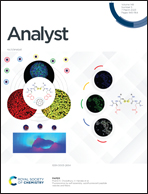Fluorescence by self-assembly: autofluorescent peptide vesicles and fibers†
Abstract
A series of oxidized cysteinyl peptides ([P-Cys-X-OMe]2; P = Boc or H; X = Trp or Glu) showed vesicular and fibrillar assemblies. The anatomy of the self-assembled vesicles from the water-soluble cystine peptide [Cys-Trp-OMe]2 (1a) has been investigated by using various fluorescent probes such as ammonium 8-anilinonaphthalene-1-sulfonate, Nile Red and pyrene. The morphological characterization was carried out by fluorescence lifetime imaging microscopy (FLIM) and super resolution-structured illumination microscopy (SR-SIM) utilizing the autofluorescence of the vesicles stemming from the self-assembly. The self-assembled structures are also observed in solution as evident from the quantitative phase images obtained using a dual-mode digital holographic microscope (DHM) system. Present investigations show that the self-assembly is enthalpy- and entropy-driven in the aqueous medium. Based on the CD spectral studies, we proposed that 1a organizes into vesicles through the sequestration of indole units. We observed that the solutions of dipeptides 1a–b exhibit autofluorescence in the blue region upon excitation at a wavelength >350 nm. Detailed spectroscopic studies on the peptides lacking tryptophan 2a–b unequivocally showed that the autofluorescence stems exclusively from peptide aggregation. Our experimental results with appropriate controls revealed that the clustering of carbonyl chromophores is central to autofluorescence. Autofluorescence was also used to probe the vesicle formation without using any external fluorescent probe. To the best of our knowledge, this is the first report on autofluorescent vesicles formed by the spontaneous association of dipeptides. We also found that the vesicles formed by 1a can act as a host for guests like C60. The biocompatibility and biodegradability of these peptides along with the autofluorescent nature and guest binding ability of peptide-based vesicles offer numerous applications in the biomedical area.



 Please wait while we load your content...
Please wait while we load your content...